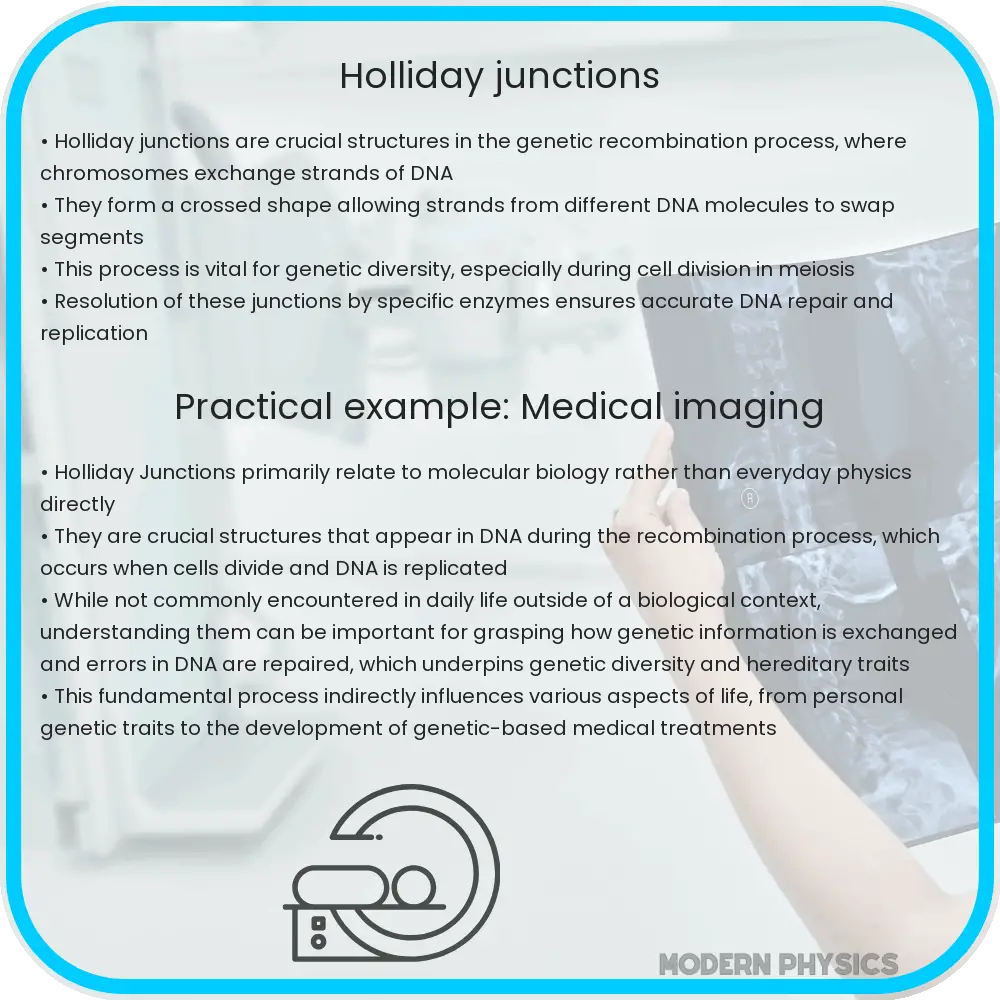Explore the structure, function, and biophysical properties of Holliday Junctions, key to genetic recombination, DNA repair, and the future of genetic engineering.

Holliday Junctions: Unveiling the Crossroads of Genetic Recombination
Holliday Junctions represent a critical nexus in the molecular choreography of genetic recombination. These structures are key players in the process of homologous recombination, a fundamental mechanism that cells employ for DNA repair, chromosome segregation, and genetic diversity during meiosis. Named after the British molecular biologist Robin Holliday, who first proposed their existence in 1964, these junctions are central to our understanding of genetic stability and variation.
Structure of Holliday Junctions
At their core, Holliday Junctions are X-shaped structures that form when two double-stranded DNA molecules exchange strands. This cross-stranded configuration allows for the transfer of genetic information between homologous chromosomes. Structurally, these junctions are dynamic, capable of adopting multiple conformations including an open square planar structure and a stacked X form, influenced by the surrounding ionic conditions and proteins that bind to them.
Function in Genetic Recombination
The primary role of Holliday Junctions lies in their facilitation of genetic recombination. During meiosis, they enable the physical exchange of genetic material between homologous chromosomes, ensuring genetic diversity among offspring. Moreover, in somatic cells, Holliday Junctions are instrumental in DNA repair processes, particularly in the repair of double-strand breaks, thus preserving genomic integrity.
Biophysics of Holliday Junctions
The biophysical properties of Holliday Junctions are as intriguing as their biological functions. Their formation, migration, and resolution are governed by complex thermodynamic and kinetic principles. The migration of the junction along the DNA – a process termed “branch migration” – is facilitated by specific enzymes and is pivotal for the proper alignment of genetic information before its exchange. The resolution of the junction, where the crossed strands are cleaved and rejoined, can occur in two ways, yielding either a crossover or non-crossover outcome. This resolution is meticulously regulated by various resolvase enzymes, ensuring that the genetic exchange is accurately executed.
Understanding the structural nuances and functional dynamics of Holliday Junctions is crucial for elucidating the mechanisms of genetic recombination and DNA repair. Their study not only sheds light on the fundamental processes of life but also has significant implications for genetic engineering, cancer research, and the treatment of genetic disorders.
Implications and Applications of Holliday Junction Research
The exploration of Holliday Junctions extends beyond basic biological research; it has profound implications for medical and technological advancements. In the realm of genetic engineering, the detailed understanding of these junctions opens avenues for genome editing techniques, allowing for precise manipulation of genetic material. This precision is crucial in developing gene therapy strategies to correct genetic disorders at their molecular roots. Furthermore, the study of Holliday Junctions contributes to cancer research, where insights into DNA repair mechanisms can lead to novel approaches to target cancer cells that rely on certain DNA repair pathways for survival.
Challenges in Holliday Junction Research
Despite significant progress, research on Holliday Junctions faces challenges. One of the primary obstacles is the dynamic nature of these structures, which complicates their study at atomic resolution. Advanced imaging and biophysical techniques are therefore essential to capture the transient states of Holliday Junctions and to understand their interactions with proteins and other molecules. Additionally, the complexity of recombination and DNA repair pathways, in which Holliday Junctions are just one component, necessitates a holistic approach to study these processes in living organisms.
Future Directions
Looking forward, the research on Holliday Junctions is poised for exciting developments. With the advent of CRISPR-Cas technologies and other genome editing tools, the manipulation of Holliday Junctions for therapeutic purposes holds great promise. Moreover, the integration of computational modeling with experimental biology could unravel the dynamic processes of recombination at unprecedented detail, offering new insights into cellular mechanisms that maintain genetic integrity.
Conclusion
Holliday Junctions are more than just fleeting structures in the cell; they are pivotal to the processes of genetic recombination and DNA repair, ensuring the stability and diversity of the genetic code. The journey from their theoretical inception to their central role in modern genetics and biomedicine highlights the importance of fundamental research in uncovering the mechanisms of life. As we advance our understanding of Holliday Junctions, we pave the way for innovative treatments for genetic diseases, cancer, and other conditions, affirming the significance of these molecular crossroads in the vast landscape of biological sciences.
